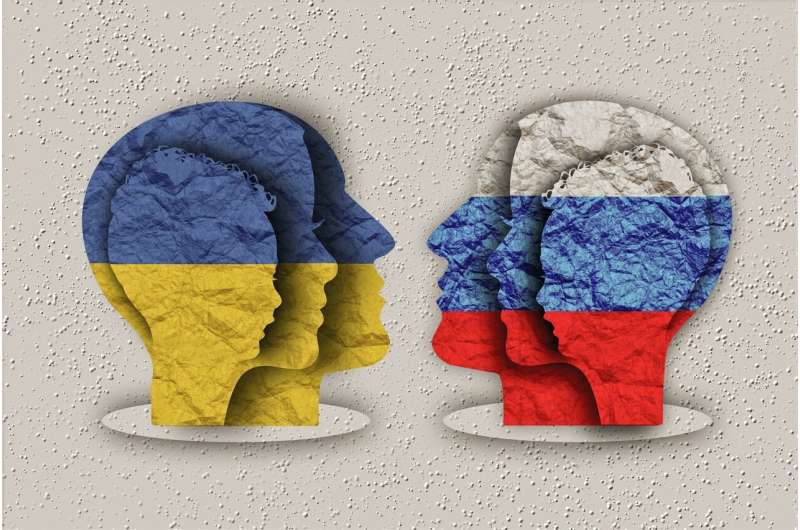This article has been reviewed according to Science X's editorial process and policies. Editors have highlighted the following attributes while ensuring the content's credibility:
fact-checked
trusted source
proofread
Data study helps explain underpinnings of Russia's invasion and Ukraine's resilience

AidData, the international development research lab based at William & Mary's Global Research Institute, have done an exhaustive study of Russia's attempts to use media, money and partnerships with sympathetic civic groups to advance its interests in Eastern Europe and Eurasia.
Ukraine was one of 17 countries closely examined, and toward the end of the three-year project, Russia invaded Ukraine to begin a war that is still ongoing after 15 months.
"I remember when we started working on this, people asked me, 'Why are you studying Russia's global influence operations? They're not all that consequential.' Well, I guess that's changed," said AidData Director of Policy Analysis Samantha Custer, who led the study along with Deputy Director Rodney Knight and Senior Research Analyst Jonathan Solis. Eight other AidData staff members and 46 W&M student research assistants were also essential to supporting and implementing the expansive project.
The research team was tasked with creating methodology and uncovering data to answer critical questions about Russia's influence in three pivotal domains—civic space, media and the energy sector—in 17 countries and seven territories in Eastern Europe and Eurasia (E&E) that the Kremlin deems within its sphere of influence.
While the AidData team was conducting its research, Russia's aggression against Ukraine was intensifying.
"I went in assuming that we would find some evidence of Kremlin influence operations, but I didn't realize until we had the benefit of hindsight just how long, slow and steady of a campaign you can see Russia engaging in well before the hot conflict with Ukraine," Custer said.
"Of course, I knew that theoretically the Russian government had the motives and means to exert pressure on local populations via various civilian influence channels, but we were seeing a pretty systematic build up to military intervention that I hadn't anticipated."
The study produced "thousands and thousands of rows of data, much of which will become publicly available, and more than 40 reports," Custer said.
Data and democracy are among the four cornerstone initiatives of W&M's Vision 2026 strategic plan.
The results of the three-year research project were released in increments starting in March. Country-specific and region-wide reports are already publicly available on the state of civic space and media resilience across Europe and Eurasia. Next month, AidData will release information on its efforts to produce a novel energy-security index. The research team looks forward to extending this work to additional years, measures and geographies, Custer said.
Ukrainian resilience
One of AidData's first reports examined Russia's use of money and media tools as early as 2015 in an attempt to apply pressure to the Ukrainian population. AidData found that these tactics worked poorly, however. Had they been in play a decade earlier, the invasion may have encountered a much different Ukraine, Custer said. Instead, what Russia ran into was a resilient country galvanized by its own civic growth.
Custer says Ukrainian citizens appeared to come to the realization after Russia invaded Crimea in 2014 that their freedom was fragile, and they had a role to play in withstanding the Kremlin's efforts to reclaim its lost empire while also holding their own leaders accountable.
"Post-Crimea, the atmosphere really changed, I think, because Russia's annexation of Crimea was so controversial for Ukrainians and seen as such an encroachment upon Ukraine's sovereignty," Custer said. "It is no coincidence that after this episode, you started to see an incremental shift and greater interest on the part of Ukrainians to become more engaged in civic life."
Ukrainians began to engage at much higher rates in common political forms of engagement like protests and strikes and demonstrations. There was also an uptick in the percentage of the population that gave to charities, volunteered their time and helped strangers.
Custer said that while Ukraine's military response to Russia's invasion has been more hardy than anticipated, what's most striking is the civil society response in a variety of ways in the middle of the conflict.
"Civil society actors are providing emergency and relief support, evacuating villages; they're routing medical and food supplies to those in need, they're providing intelligence-gathering and logistical support for the military," Custer said.
"My sense is that a lot of that was motivated by this feeling of, 'Hey we're under attack. We need to join forces and rally to protect our country.' I don't know that Russia anticipated the strength of that reaction," Custer said.
Provided by William & Mary





















